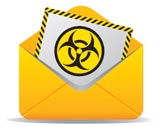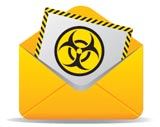
Special Delivery
New technology developed after 9/11 could help pre-empt biohazard mail assaults
- By Jonathan Morrone
- Oct 02, 2008
 It likely won’t make the nightly news. Neither the victim
nor the perpetrator will ever be identified, at least
publicly. We can go on with our daily lives with one
less piece of bad news tugging downward on our psyche.
But it will cost us plenty -- in lost productivity, millions of
tax dollars, anxiety and, in some cases, our dignity.
It likely won’t make the nightly news. Neither the victim
nor the perpetrator will ever be identified, at least
publicly. We can go on with our daily lives with one
less piece of bad news tugging downward on our psyche.
But it will cost us plenty -- in lost productivity, millions of
tax dollars, anxiety and, in some cases, our dignity.
Out of sight is out of mind. But when the rash of
“white, powdery substance” threats was reported heavily
following the Sept. 11, 2001, attacks, water-cooler
chatter centered on genuine concern and heartfelt angst
about a nationwide disaster and possible random attacks
on residential targets and people. Some parents felt
threatened enough to forbid their children from retrieving
mail from the curbside mailbox.
The year following 9/11, there were at least 15,000
white-powder incident reports throughout the United
States, according to the FBI. Nearly all were mail-related,
and all but a handful were hoaxes or cases of mistaken
identity. In the cases of the confirmed anthrax attacks,
five people died, nearly 20 were hospitalized and hundreds
went through hazmat decontamination.
It was a scary time, but it’s old news.
Biothreats Still Real
Today, the frequency of white-powder hoaxes is nearly
the same as seven years ago, according to the Centers for
Disease Control, but it just doesn’t make news. While
the threat to people’s health may not be real in the event
of a hoax, the threat to a livelihood exists. The economic
costs to respond to any bioterrorism threat are high --
in terms of productivity and revenue loss as well as public
expenditure for emergency response and cleanup.
Businesses close, government offices are quarantined
and school buildings are locked down.
In the aftermath of 9/11, laboratories were swamped
with requests to test specimens for anthrax, delaying
treatment and evaluation for others in need of medical
diagnosis. Terrorist threats, even if they are hoaxes, are
still terrorist threats. And by now we all know that is one
of the main goals of terrorism: to create public fear.
Any bioterrorism threat must be treated seriously by
authorities, meaning all emergency response teams have
to be on-scene and operate according to protocol to
respond, decontaminate and investigate an incident --
even when it is likely that the suspicious substance is not
harmful. The cost in public resources is taxing. Those
who often respond include hazmat teams, local police,
firefighters, paramedics, FBI and hospital staff.
Things have changed over the past seven years:
Private companies, government agencies and even K-12
school districts have sought an affordable, proactive
approach to thwart biohazardous threats through the
mail -- hoax or otherwise. It has been considered economically
viable and even prudent to have such a detection
system.
But one of the significant drawbacks to most of these
systems has been that the methods and technologies
often cause material harm -- discoloration, burning,
opening and harmful chemical destabilization -- to the
mail. And most systems use irradiation, which costs millions
of dollars per unit, making it affordable only to the
largest agencies or corporate enterprises.
Recently, however, new technology has been developed
and deployed to detect and neutralize biohazardous
agents while preserving the integrity and usability of the
suspected tainted materials. Mail can be scanned and, if
necessary, a biological agent can be detected and
destroyed before it reaches any potential victim. The new
units are affordable for school districts, hospitals, small
businesses and government agencies, especially when
measured against the costs of experiencing even one
bioterrorism hoax.
Affordable Alternatives
Businesses and government agencies need to take into
account several factors when considering a pre-emptive
solution for potential biothreats through the mail. These
are the same considerations that developers of next-generation
solutions need to bear in mind to help protect
people from harmful biological agents and health hazards
that are found in many everyday situations.
An organization must weigh the economic,
psychological and health risks of
even one event or hoax against the cost of
implementing and maintaining a preventative
measure. Today, it is possible to have
installed a tested and proven detection system
for less than $200,000, and in some
cases for as little as $90,000. Unlike
expensive irradiation systems, these scanning
units provide an affordable, on-site
mail-protection solution for many organizations
and many different situations.
Organizations must consider the
importance of maintaining business continuity.
As illustrated by the anthrax
attacks after 9/11, even the slightest
quantity of anthrax -- in one letter -- can
compromise an entire organization, rendering
a facility and its operations useless
for a long time.
The Hamilton, N.J., post office that
handled the October 2001 anthrax-laced
letters was closed for more than three years
after the deadly mailings. The building was
decontaminated and now has sensors to
detect anthrax. But all the old equipment
was replaced at a cost between $80 million
and $100 million dollars, according to
reports by the Associated Press. According
to government officials, cleanup alone was
estimated in the hundreds of millions of
dollars. Even with a suspected hoax, a oneday
interruption could cost hundreds of
thousands of dollars in revenue or productivity
loss, in addition to response and
cleanup costs.
Systems developed to meet the
demands of business and government
organizations must be designed to provide
a significantly higher level of protection
without material disruption to an
organization’s existing mail processing
system. Given the vulnerability of the
mail system, it is susceptible to attack at
any number of points. As such, a solution
designed to protect at the point of delivery
or end user provides the surest
method of protection. And again, unlike
most of the technologies in use today by
larger organizations, biological attack
protection needs to be provided without
causing material harm to the mail.
New biosecurity systems must be safe
to operate and safe for the environment.
Technology is being used today that is
completely safe to those who operate,
service and work in the vicinity of the
biodetection and neutralization units. As
irradiation has shown, there are dangers in
using high levels of radiation, and the public
has become wary of technologies that
rely on heavy doses of radiation.
Biohazard Defense
After several years of research and development
following 9/11, a group of scientists,
engineers and business professionals
with experience in biochemistry, military
science, high-tech systems and the computer
industry assembled a small portable
system that combined proven disinfection
technologies -- including electromagnetic
irradiation, ultraviolet, microwave, highintensity
broadband beam, infrared and
other light sources -- oxidization and other
commercialized technologies to destroy
biological contaminants and neutralize
chemical toxins, including anthrax,
smallpox, plague , E-coli, influenza, HIV,
botulism and ricin.
Today, this system is providing security
for mailrooms, ports, border crossings,
military bases and other facilities around
the world where effective threat and contraband
detection is critical. Called MailDefender, the system also is
deployed at the United Nations; departments
of Justice, Defense, and Alcohol,
Tobacco and Firearms; and at several
embassies worldwide.
The company that developed
MailDefender, BioDefense Corp., has
proved that its technology kills anthrax
in the mail and is safe for both the mail
and individuals when used properly.
Professor Hong-Liang Cui, director of
the Applied Electronics Laboratory, an
Army-funded laboratory at the Stevens
Institute of Technology in Hoboken,
N.J., concluded after testing the system
that “a combination of ultraviolet radiation
and microwave radiation was the
most effective way to destroy biological
pathogens.” Hong-Liang’s team tested
the system’s ability to kill biological
pathogens by examining its ability to kill
the biological indicator most often used
as a surrogate to Bacillus anthracis --
commonly known as anthrax -- Bacillus
subtilis var. niger spores. Typical killing
rates obtained were in the range of 10-4
~ 10-6, a level exceeding Army regulations,
with the best results obtained
approaching 10-7.
Hong-Liang’s team also tested operational
issues related to mail sanitization
processes. This includes material degradation
effects from the sanitization
process -- on mail and other material
often found in mail -- plus safety issues,
such as production of volatile organic
compounds and radiation hazards from
the device. Tests “resulted in minimum
material damage and efficient killing of
the biological pathogens.”
The system provides an on-site office
solution for disinfecting and decontaminating
mail at the point of entry and making
the working environment safer and
healthier. It can be installed and operated
in an office or manufacturing facility
without fear of illness or other hazards
from using the system. MailDefender
decontaminates up to 3 pounds -- approximately
150 pieces -- of mail per cycle
within 55 minutes, and the units can be
stacked and run simultaneously to
increase capacity and decontaminate
more mail faster.
MailDefender also has been adapted
to mobile and fast-response situations.
When a biohazardous situation occurs,
nothing is more important than containing
the threat to public safety and getting
an emergency response team to the site
quickly and safely. The mobile unit provides
first responders access to protective
clothing and gear. When they arrive onsite,
suspicious materials instantly can be
contained and decontaminated in the
emergency response vehicle’s unit.
The threat of bioterrorism is still out
there; it occurs every day. According to
the FBI, in Washington, D.C., alone,
emergency response teams still respond
to an average of 10 suspected threats or
hoaxes per week, costing taxpayers and
business owners millions of dollars.
New advances in technology and affordable
solutions are an attempt to mitigate
the economic loss and grant at least an
acceptable level of peace of mind.